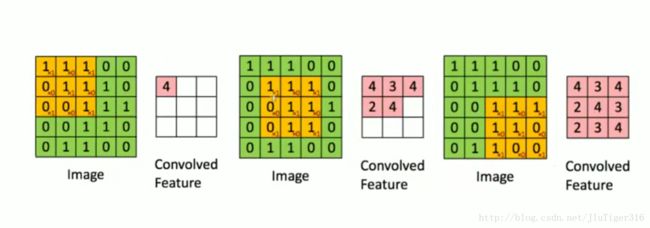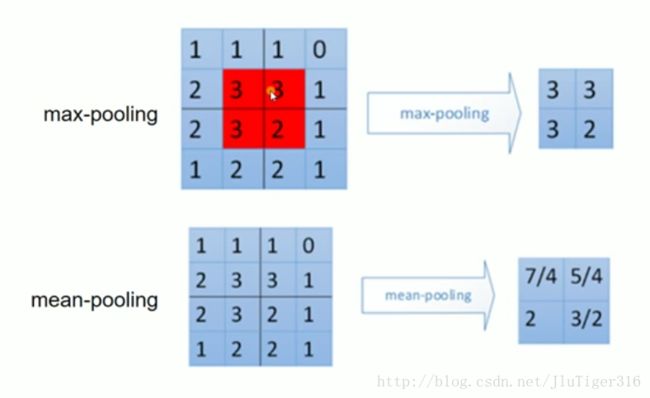深度学习框架TensorFlow学习与应用(六)——卷积神经网络应用于MNIST数据集分类
传统神经网络存在的问题:
1.权值太多,计算量太大。
2.权值太多,需要大量样本进行训练。
局部感受野:
1962年哈佛医学院神经生理学家Hubel和Wiesel通过对猫视觉皮层细胞的研究,提出了感受野(receptive field)的概念,1984年日本学者Fukushima基于感受野概念提出的神经认知机(neocognitron)可以看作是卷积神经网络的第一个实现网络,也是感受野概念在人工神经网络领域的首次应用。
卷积神经网络CNN:
CNN通过感受野和权值共享减少了神经网络需要训练的参数个数。
卷积:
池化 :
对于卷积操作:
SAME PADDING: 给平面外部补0,卷积窗口采样后得到一个跟原来平面大小相同的平面。
VALID PADDING: 不会超出平面外部,卷积窗口采样后得到一个比原来平面小的平面。
对于池化操作:
SAME PADDING: 可能会给平面外部补0。
VALID PADDING: 不会超出平面外部。
假如有一个28*28的平面,用2*2并且步长为2的窗口对其进行pooling操作
使用SAME PADDING的方式,得到14*14的平面
使用VALID PADDING的方式,得到14*14的平面
假如有一个2*3的平面,用2*2并且步长为2的窗口对其进行pooling操作
使用SAME PADDING的方式,得到1*2的平面
使用VALID PADDING的方式,得到1*1的平面
CNN结构:
卷积神经网络应用于MNIST数据集分类:
import tensorflow as tf
from tensorflow.examples.tutorials.mnist import input_data
mnist=input_data.read_data_sets("D:\BaiDu\MNIST_data",one_hot=True)
#每个批次的大小
batch_size=100
#计算一共有多少个批次
n_batch=mnist.train.num_examples//batch_size
#初始化权值
def weight_variable(shape):
initial=tf.truncated_normal(shape,stddev=0.1)#生成一个截断的正态分布
return tf.Variable(initial)
#初始化偏置
def bias_variable(shape):
initial=tf.constant(0.1,shape=shape)
return tf.Variable(initial)
#卷积层
def conv2d(x,W):
#x input tensor of shape '[batch,in_height,in_width,in_channles]'
#W filter / kernel tensor of shape [filter_height,filter_width,in_channels,out_channels]
#`strides[0] = strides[3] = 1`. strides[1]代表x方向的步长,strides[2]代表y方向的步长
#padding: A `string` from: `"SAME", "VALID"`
return tf.nn.conv2d(x,W,strides=[1,1,1,1],padding='SAME')#2d的意思是二维的卷积操作
#池化层
def max_pool_2x2(x):
#ksize [1,x,y,1]
return tf.nn.max_pool(x,ksize=[1,2,2,1],strides=[1,2,2,1],padding='SAME')
#定义两个placeholder
x = tf.placeholder(tf.float32,[None,784])#28*28
y = tf.placeholder(tf.float32,[None,10])
#改变x的格式转为4D的向量[batch, in_height, in_width, in_channels]`
x_image = tf.reshape(x,[-1,28,28,1])
#初始化第一个卷积层的权值和偏置
W_conv1 = weight_variable([5,5,1,32])#5*5的采样窗口,32个卷积核从1个平面抽取特征
b_conv1 = bias_variable([32])#每一个卷积核一个偏置值
#把x_image和权值向量进行卷积,再加上偏置值,然后应用于relu激活函数
h_conv1 = tf.nn.relu(conv2d(x_image,W_conv1)+b_conv1)
h_pool1 = max_pool_2x2(h_conv1)#进行max-pooling
#初始化第二个卷积层的权值和偏置
W_conv2 = weight_variable([5,5,32,64])#5*5的采样窗口,64个卷积核从32个平面抽取特征
b_conv2 = bias_variable([64])#每一个卷积核一个偏置值
#把h_pool1和权值向量进行卷积,再加上偏置值,然后应用于relu激活函数
h_conv2 = tf.nn.relu(conv2d(h_pool1,W_conv2) + b_conv2)
h_pool2 = max_pool_2x2(h_conv2)#进行max-pooling
#28*28的图片第一次卷积后还是28*28,第一次池化后变为14*14
#第二次卷积后为14*14,第二次池化后变为了7*7
#进过上面操作后得到64张7*7的平面
#初始化第一个全连接层的权值
W_fc1 = weight_variable([7*7*64,1024])#上一层有7*7*64个神经元,全连接层有1024个神经元
b_fc1 = bias_variable([1024])#1024个节点
#把池化层2的输出扁平化为1维
h_pool2_flat = tf.reshape(h_pool2,[-1,7*7*64])
#求第一个全连接层的输出
h_fc1 = tf.nn.relu(tf.matmul(h_pool2_flat,W_fc1) + b_fc1)
#keep_prob用来表示神经元的输出概率
keep_prob = tf.placeholder(tf.float32)
h_fc1_drop = tf.nn.dropout(h_fc1,keep_prob)
#初始化第二个全连接层
W_fc2 = weight_variable([1024,10])
b_fc2 = bias_variable([10])
#计算输出
prediction = tf.nn.softmax(tf.matmul(h_fc1_drop,W_fc2) + b_fc2)
#交叉熵代价函数
cross_entropy = tf.reduce_mean(tf.nn.softmax_cross_entropy_with_logits(labels=y,logits=prediction))
#使用AdamOptimizer进行优化
train_step = tf.train.AdamOptimizer(1e-4).minimize(cross_entropy)
#结果存放在一个布尔列表中
correct_prediction = tf.equal(tf.argmax(prediction,1),tf.argmax(y,1))#argmax返回一维张量中最大的值所在的位置
#求准确率
accuracy = tf.reduce_mean(tf.cast(correct_prediction,tf.float32))
with tf.Session() as sess:
sess.run(tf.global_variables_initializer())
for epoch in range(21):
for batch in range(n_batch):
batch_xs,batch_ys = mnist.train.next_batch(batch_size)
sess.run(train_step,feed_dict={x:batch_xs,y:batch_ys,keep_prob:0.7})
acc=sess.run(accuracy,feed_dict={x:mnist.test.images,y:mnist.test.labels,keep_prob:1.0})
print("Iter "+str(epoch)+", Testing Accuracy= "+str(acc))经过训练,准确率最高能达到99.2%左右,高于传统神经网络的准确率。下面给出用TensorBoard绘制卷积神经网络的结构设计,由于电脑最近有点小问题,就不给出相关图示信息啦。。。
import tensorflow as tf
from tensorflow.examples.tutorials.mnist import input_data
mnist = input_data.read_data_sets('MNIST_data',one_hot=True)
#每个批次的大小
batch_size = 100
#计算一共有多少个批次
n_batch = mnist.train.num_examples // batch_size
#参数概要
def variable_summaries(var):
with tf.name_scope('summaries'):
mean = tf.reduce_mean(var)
tf.summary.scalar('mean', mean)#平均值
with tf.name_scope('stddev'):
stddev = tf.sqrt(tf.reduce_mean(tf.square(var - mean)))
tf.summary.scalar('stddev', stddev)#标准差
tf.summary.scalar('max', tf.reduce_max(var))#最大值
tf.summary.scalar('min', tf.reduce_min(var))#最小值
tf.summary.histogram('histogram', var)#直方图
#初始化权值
def weight_variable(shape,name):
initial = tf.truncated_normal(shape,stddev=0.1)#生成一个截断的正态分布
return tf.Variable(initial,name=name)
#初始化偏置
def bias_variable(shape,name):
initial = tf.constant(0.1,shape=shape)
return tf.Variable(initial,name=name)
#卷积层
def conv2d(x,W):
#x input tensor of shape `[batch, in_height, in_width, in_channels]`
#W filter / kernel tensor of shape [filter_height, filter_width, in_channels, out_channels]
#`strides[0] = strides[3] = 1`. strides[1]代表x方向的步长,strides[2]代表y方向的步长
#padding: A `string` from: `"SAME", "VALID"`
return tf.nn.conv2d(x,W,strides=[1,1,1,1],padding='SAME')
#池化层
def max_pool_2x2(x):
#ksize [1,x,y,1]
return tf.nn.max_pool(x,ksize=[1,2,2,1],strides=[1,2,2,1],padding='SAME')
#命名空间
with tf.name_scope('input'):
#定义两个placeholder
x = tf.placeholder(tf.float32,[None,784],name='x-input')
y = tf.placeholder(tf.float32,[None,10],name='y-input')
with tf.name_scope('x_image'):
#改变x的格式转为4D的向量[batch, in_height, in_width, in_channels]`
x_image = tf.reshape(x,[-1,28,28,1],name='x_image')
with tf.name_scope('Conv1'):
#初始化第一个卷积层的权值和偏置
with tf.name_scope('W_conv1'):
W_conv1 = weight_variable([5,5,1,32],name='W_conv1')#5*5的采样窗口,32个卷积核从1个平面抽取特征
with tf.name_scope('b_conv1'):
b_conv1 = bias_variable([32],name='b_conv1')#每一个卷积核一个偏置值
#把x_image和权值向量进行卷积,再加上偏置值,然后应用于relu激活函数
with tf.name_scope('conv2d_1'):
conv2d_1 = conv2d(x_image,W_conv1) + b_conv1
with tf.name_scope('relu'):
h_conv1 = tf.nn.relu(conv2d_1)
with tf.name_scope('h_pool1'):
h_pool1 = max_pool_2x2(h_conv1)#进行max-pooling
with tf.name_scope('Conv2'):
#初始化第二个卷积层的权值和偏置
with tf.name_scope('W_conv2'):
W_conv2 = weight_variable([5,5,32,64],name='W_conv2')#5*5的采样窗口,64个卷积核从32个平面抽取特征
with tf.name_scope('b_conv2'):
b_conv2 = bias_variable([64],name='b_conv2')#每一个卷积核一个偏置值
#把h_pool1和权值向量进行卷积,再加上偏置值,然后应用于relu激活函数
with tf.name_scope('conv2d_2'):
conv2d_2 = conv2d(h_pool1,W_conv2) + b_conv2
with tf.name_scope('relu'):
h_conv2 = tf.nn.relu(conv2d_2)
with tf.name_scope('h_pool2'):
h_pool2 = max_pool_2x2(h_conv2)#进行max-pooling
#28*28的图片第一次卷积后还是28*28,第一次池化后变为14*14
#第二次卷积后为14*14,第二次池化后变为了7*7
#进过上面操作后得到64张7*7的平面
with tf.name_scope('fc1'):
#初始化第一个全连接层的权值
with tf.name_scope('W_fc1'):
W_fc1 = weight_variable([7*7*64,1024],name='W_fc1')#上一场有7*7*64个神经元,全连接层有1024个神经元
with tf.name_scope('b_fc1'):
b_fc1 = bias_variable([1024],name='b_fc1')#1024个节点
#把池化层2的输出扁平化为1维
with tf.name_scope('h_pool2_flat'):
h_pool2_flat = tf.reshape(h_pool2,[-1,7*7*64],name='h_pool2_flat')
#求第一个全连接层的输出
with tf.name_scope('wx_plus_b1'):
wx_plus_b1 = tf.matmul(h_pool2_flat,W_fc1) + b_fc1
with tf.name_scope('relu'):
h_fc1 = tf.nn.relu(wx_plus_b1)
#keep_prob用来表示神经元的输出概率
with tf.name_scope('keep_prob'):
keep_prob = tf.placeholder(tf.float32,name='keep_prob')
with tf.name_scope('h_fc1_drop'):
h_fc1_drop = tf.nn.dropout(h_fc1,keep_prob,name='h_fc1_drop')
with tf.name_scope('fc2'):
#初始化第二个全连接层
with tf.name_scope('W_fc2'):
W_fc2 = weight_variable([1024,10],name='W_fc2')
with tf.name_scope('b_fc2'):
b_fc2 = bias_variable([10],name='b_fc2')
with tf.name_scope('wx_plus_b2'):
wx_plus_b2 = tf.matmul(h_fc1_drop,W_fc2) + b_fc2
with tf.name_scope('softmax'):
#计算输出
prediction = tf.nn.softmax(wx_plus_b2)
#交叉熵代价函数
with tf.name_scope('cross_entropy'):
cross_entropy = tf.reduce_mean(tf.nn.softmax_cross_entropy_with_logits(labels=y,logits=prediction),name='cross_entropy')
tf.summary.scalar('cross_entropy',cross_entropy)
#使用AdamOptimizer进行优化
with tf.name_scope('train'):
train_step = tf.train.AdamOptimizer(1e-4).minimize(cross_entropy)
#求准确率
with tf.name_scope('accuracy'):
with tf.name_scope('correct_prediction'):
#结果存放在一个布尔列表中
correct_prediction = tf.equal(tf.argmax(prediction,1),tf.argmax(y,1))#argmax返回一维张量中最大的值所在的位置
with tf.name_scope('accuracy'):
#求准确率
accuracy = tf.reduce_mean(tf.cast(correct_prediction,tf.float32))
tf.summary.scalar('accuracy',accuracy)
#合并所有的summary
merged = tf.summary.merge_all()
with tf.Session() as sess:
sess.run(tf.global_variables_initializer())
train_writer = tf.summary.FileWriter('logs/train',sess.graph)
test_writer = tf.summary.FileWriter('logs/test',sess.graph)
for i in range(1001):
#训练模型
batch_xs,batch_ys = mnist.train.next_batch(batch_size)
sess.run(train_step,feed_dict={x:batch_xs,y:batch_ys,keep_prob:0.5})
#记录训练集计算的参数
summary = sess.run(merged,feed_dict={x:batch_xs,y:batch_ys,keep_prob:1.0})
train_writer.add_summary(summary,i)
#记录测试集计算的参数
batch_xs,batch_ys = mnist.test.next_batch(batch_size)
summary = sess.run(merged,feed_dict={x:batch_xs,y:batch_ys,keep_prob:1.0})
test_writer.add_summary(summary,i)
if i%100==0:
test_acc = sess.run(accuracy,feed_dict={x:mnist.test.images,y:mnist.test.labels,keep_prob:1.0})
train_acc = sess.run(accuracy,feed_dict={x:mnist.train.images[:10000],y:mnist.train.labels[:10000],keep_prob:1.0})
print ("Iter " + str(i) + ", Testing Accuracy= " + str(test_acc) + ", Training Accuracy= " + str(train_acc))



